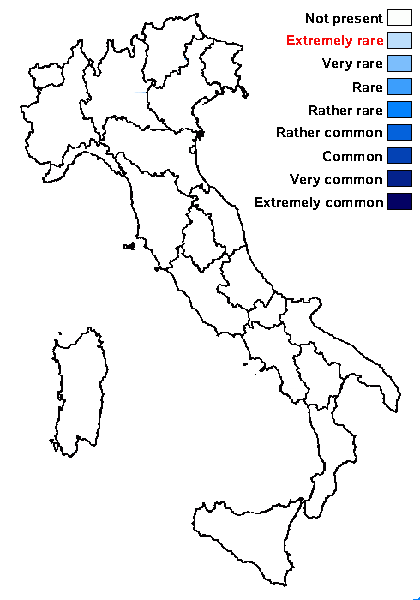Thelocarpon saxicola (Zahlbr.) H. Magn.
Rabenhorsts'. Krypt.-Fl., 2nd ed., 9, 5.1: 297, 1935. Basionym: Thelocarpon epibolum var. saxicola Zahlbr. - Cat. Lich. Univ., 5: 3, 1928
Synonyms:
Distribution:
Description: Thallus crustose, not lichenized, reduced to 0.1-0.2 mm wide, globose, scattered, coarsely yellow-pruinose fruiting warts. Ascocarps frequent, perithecioid, immersed in the warts, with a concave, not exposed disc (the warts opening though a small pore). Exciple colourless, c. 25 μm thick in upper part, 10-15 μm thick in lower part, devoid of algae; hymenial gel I+ yellow to reddish, K/I+ blue; paraphyses absent; periphyses sparingly branched, 20-25 μm long, the longest ones arranged around the ostiole, the shortest on the sides. Asci many-spored, flask-shaped, persistent, thin-walled, the wall I-, not thickened at apex. Ascospores 1-celled, hyaline, long-ellipsoid, thin-walled, sometimes slightly curved, 4-7 x 2-3 μm. Photobiont absent. Spot tests: K-, C-, KC-, P-. Chemistry: yellow pruina with pulvinic acid derivatives. Note: an ephemeral, non-lichenized species found on sandstone and similar rocks, usually in shaded-humid situations, such as in forests; widespread but rare or overlooked in Western and Central Europe, with a single record from the Eastern Alps (Austria). To be looked for in Italy.
Growth form: Fungus
Substrata: rocks
Reproductive strategy: mainly sexual
Pioneer species

Predictive model
Growth form: Fungus
Substrata: rocks
Reproductive strategy: mainly sexual
Pioneer species

Predictive model
 Index Fungorum
Index Fungorum
 GBIF
GBIF

